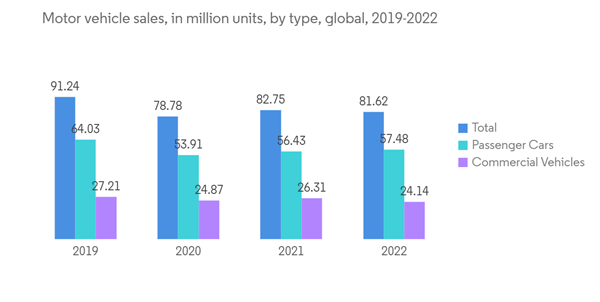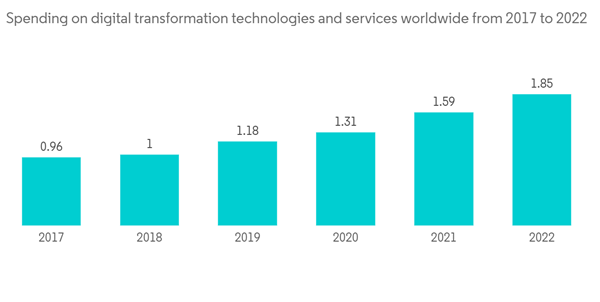The Precision Turned Product Manufacturing Market size is estimated at USD 113.93 billion in 2024, and is expected to reach USD 154.26 billion by 2029, growing at a CAGR of 6.25% during the forecast period (2024-2029).
The demand for cutting-edge machining solutions is driving sales growth, and the focus on reducing downtime to increase production speed, accuracy, and machining processes is also driving growth. Industry 4.0 encourages manufacturing facilities to link up with other business functions to create complex and adaptive automation systems that use manufacturing and production precision engineering machinery. So, there are lots of opportunities in the sector as Industry 4.0 flourishes in the coming years.
The aerospace industry, which includes R&D and manufacturing of the full range of systems, electronics, and equipment for both civilian and defense markets, is currently experiencing global growth and is unlikely to experience recessionary pressures. However, the world’s top commercial aerospace OEMs predict that by 2023 or early 2024, global passenger traffic is expected to return to 2019 levels. This could lead to ramp-ups to address growing backlogs and boost industry revenue. One of the reasons for this increase can be attributed to the increase in defense budgets after the outbreak of war in Ukraine, which led to an increase in global demand for military equipment.
Because of their computerized precision, precision engineering machines are becoming increasingly popular as manufacturing processes become more efficient and productive. Technology is advancing, and the scope of precision engineering is expanding. Precision engineering machines allow for automated processes and, therefore, reduce the time required for component machining.
Once the codes are fed into the computer by the machinist, the machines can run without manual intervention and control. Robots, also known as industrial automated machines (IAMs), have proven to be beneficial for discrete and continuous manufacturers alike in a variety of ways. Some of these benefits include increased efficiency and more efficient manufacturing processes.
There were approximately 85 million motor vehicles produced in the world in 2022. This represents an increase of about 6% compared to the previous year. It is expected that this number will continue to increase in the coming years due to the growing population, urbanization, and personalization.
With the growth of e-commerce, the demand for small, medium, and large commercial trucks in logistics and transportation has increased significantly. The logistics industry is no longer just about providing services but providing customer-oriented solutions. Therefore, the demand for commercial trucks for transportation has increased exponentially.
Connectivity and communication may become more crucial as the amount of data being recorded, analyzed, and stored, along with the number of smart devices, increases. Companies require their data to be interoperable and shared both within an organization and with outside partners to enable higher levels of operations.
Through the use of digital overlays, mixed reality devices can link the person on site with a third party with the necessary skills so they can learn how to make the repairs step-by-step.
In the past, manufacturing companies that wanted to stay competitive had to outsource to low-wage countries. Richer nations are now able to compete because of technological advancements.
Premier Farnell Corp., HES Präzisionsteile Hermann Erkert GmbH, KPF, Melling Tool Co., and Paul Bippus GmbH & Co. KG are a few of the key companies active in the sector.
This product will be delivered within 2 business days.
The demand for cutting-edge machining solutions is driving sales growth, and the focus on reducing downtime to increase production speed, accuracy, and machining processes is also driving growth. Industry 4.0 encourages manufacturing facilities to link up with other business functions to create complex and adaptive automation systems that use manufacturing and production precision engineering machinery. So, there are lots of opportunities in the sector as Industry 4.0 flourishes in the coming years.
The aerospace industry, which includes R&D and manufacturing of the full range of systems, electronics, and equipment for both civilian and defense markets, is currently experiencing global growth and is unlikely to experience recessionary pressures. However, the world’s top commercial aerospace OEMs predict that by 2023 or early 2024, global passenger traffic is expected to return to 2019 levels. This could lead to ramp-ups to address growing backlogs and boost industry revenue. One of the reasons for this increase can be attributed to the increase in defense budgets after the outbreak of war in Ukraine, which led to an increase in global demand for military equipment.
Because of their computerized precision, precision engineering machines are becoming increasingly popular as manufacturing processes become more efficient and productive. Technology is advancing, and the scope of precision engineering is expanding. Precision engineering machines allow for automated processes and, therefore, reduce the time required for component machining.
Once the codes are fed into the computer by the machinist, the machines can run without manual intervention and control. Robots, also known as industrial automated machines (IAMs), have proven to be beneficial for discrete and continuous manufacturers alike in a variety of ways. Some of these benefits include increased efficiency and more efficient manufacturing processes.
Precision Turned Product Manufacturing Market Trends
Automotive Industry is driving the market
The auto industry is the biggest user of precision machined parts, so it's important to make sure they're accurate and with tight tolerances. Automotive parts need to fit into place and be of good quality to work properly, and if they're not machined to the right specifications, it can lead to problems like lower fuel efficiency, engine failure, and accidents. Precision-turned components are used in the auto industry for a variety of purposes, like throttle control shafts, low pass filters, hydraulic valves, valve housings, sensor housings, temperature sensor housings, pressure sensor housings, pipe joints, sensor metal shells, etc. They make sure the parts are accurate, durable, and work properly, which helps keep your car running smoothly and safely.There were approximately 85 million motor vehicles produced in the world in 2022. This represents an increase of about 6% compared to the previous year. It is expected that this number will continue to increase in the coming years due to the growing population, urbanization, and personalization.
With the growth of e-commerce, the demand for small, medium, and large commercial trucks in logistics and transportation has increased significantly. The logistics industry is no longer just about providing services but providing customer-oriented solutions. Therefore, the demand for commercial trucks for transportation has increased exponentially.
Industry 4.0 Revolutionizing the Manufacturing Industry
Industry 4.0 involves modernizing production and enhancing the competitiveness of the Western industrial sector. It is centered on improved robotics and automation, new human-machine interaction forms, massive data troves, and increasing connectivity. With the help of IoT and highly effective, automated robotics, manufacturers can gather, analyze, and take action on enormous stockpiles of data.Connectivity and communication may become more crucial as the amount of data being recorded, analyzed, and stored, along with the number of smart devices, increases. Companies require their data to be interoperable and shared both within an organization and with outside partners to enable higher levels of operations.
Through the use of digital overlays, mixed reality devices can link the person on site with a third party with the necessary skills so they can learn how to make the repairs step-by-step.
In the past, manufacturing companies that wanted to stay competitive had to outsource to low-wage countries. Richer nations are now able to compete because of technological advancements.
Precision Turned Product Manufacturing Industry Overview
There are many major players in the market. Since none of the competitors control a sizable portion of the market, it is fragmented. The rivals are coming up with new strategies to assert their superiority.Premier Farnell Corp., HES Präzisionsteile Hermann Erkert GmbH, KPF, Melling Tool Co., and Paul Bippus GmbH & Co. KG are a few of the key companies active in the sector.
Additional Benefits:
- The market estimate (ME) sheet in Excel format
- 3 months of analyst support
This product will be delivered within 2 business days.
Table of Contents
1 INTRODUCTION
4 MARKET INSIGHTS AND DYNAMICS
5 MARKET SEGMENTATION
6 COMPETITIVE LANDSCAPE
Methodology

LOADING...










